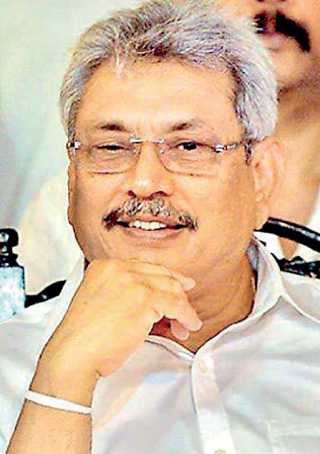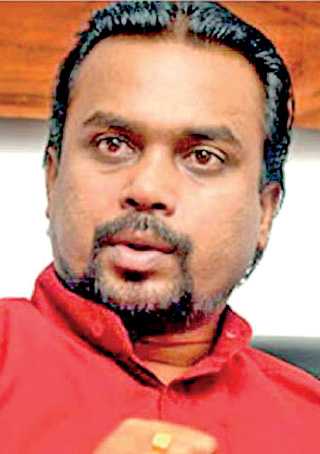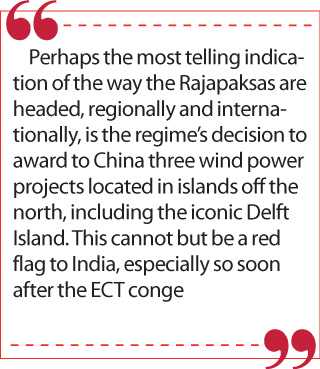Sunday Dec 21, 2025
Sunday Dec 21, 2025
Wednesday, 10 February 2021 00:30 - - {{hitsCtrl.values.hits}}

President Gotabaya Rajapaksa

PM Mahinda Rajapaksa

Minister Wimal Weerawansa
“Down, down, down. Would the fall never come to an end!”
– Lewis Carroll (Alice in Wonderland)
By Tisaranee Gunasekara
 |
 |
 |
February began with portents.
The Army Commander laid the foundation stone for a temple complex in Kankasanturai, Tissa Raja Maha Viharaya, named after King Devanampiyatissa. The construction of the 100-foot chaithya will be handled by the Army.
The National Anthem in Tamil was banished from Independence Day celebrations for the second successive year. President Gotabaya used his Independence Day speech to parade his Sinhala-Buddhist credentials.
The Government, ignoring scientific advice, continued to forcibly cremate the Muslim COVID-dead.
There were good omens too. At the Vavuniya Independence Day celebrations, Tamil students sang the National Anthem in Sinhala while Sinhala students sang the National Anthem in Tamil.
The march from Pottuvil to Polikandy (P2P) turned into a joint protest by Tamils and Muslims of the North and the East, perhaps the first ever. The march, wending across all districts of the two provinces, remained peaceful despite regime’s provocations.
Tamils and Muslims, divided by Tiger extremism, were brought together by Rajapaksa extremism. Muslim religious and political establishments, vociferous on issues such as MMDA reform, were mostly silent on the Gotabaya-Mahinda Government’s insistence on forcible cremations. In stark contrast, many Tamil politicians condemned the regime’s anti-science and racist practice in strong and unequivocal terms.
The burial issue was included among the core-demands of the P2P protest, together with militarisation, land grabbing, and repression. In a reflection of the times, the main focus of the march was on issues relating to basic security, dignity, and equality, fundamental rights guaranteed by the Constitution to all Lankans but denied in practice to most minorities.
For the Rajapaksas, the minorities are aliens, permanent guests who will be allowed to live on sufferance, and on terms of manifest and submissive inequality. A case in point is the strangely similar genesis of the National Anthem and burial issues.
President Mahinda Rajapaksa banned the singing of the National Anthem in Tamil in December 2010, probably as a kneejerk reaction to the cancellation of his Oxford Union lecture due to pressure from a segment of the Tamil diaspora.
Soon after his return from the UK, he excoriated the singing of National Anthem in Tamil as “a shortcoming that must be rectified” (The Sunday Times – 12 December 2010). He insisted that “In no other country was the national anthem used in more than one language,” a statement as anti-factual as the current Government’s claims of ground water contamination via COVID-dead burials.
Petty actions like these are aimed at reminding non-Sinhala-Buddhists of their unequal status. They are also wedge issues, indispensable in widening the gap between the minorities and the majority. The regime’s response to the Tamil-Muslim rapprochement that is birthing too will be loud and hysterical, replete with howls about undead Tigers and Islamic extremists uniting to divide Sri Lanka and bomb Sinhala south to smithereens.
The march from east to north has created a unity between Tamils and Muslims, long-fractured by the LTTE’s brutal monomania. It was a heartening sight to see Hindu, Muslim and Christian and Catholic priests and nuns at the head of the procession. Hopefully, P2P will be the first step in creating a movement from the ground which pushes the Opposition in the direction it must go if we are to defeat not just the Rajapaksa project but also the divisive and atomising ideology.
Commissioned!
A war-of-words has commenced between the SLPP hierarchy and Wimal Weerawansa. Accusations are being bandied and revelations made.
Wimal Weerawansa is unquestioningly loyal to Mahinda and Gotabaya Rajapaksa. But his loyalty stops there. His problems with Basil Rajapaksa are no secret. In short, he, like many others in and around the SLPP, is willing to remain a political serf of Mahinda and Gotabaya Rajapaksa, but not of any other member of the family. Since dynastic succession is a fundamental feature of the Rajapaksa project, his lack of fealty to other members of the clan pits him against not just them but also the president and the premier. Minister Weerawansa’s unwillingness to embrace a Basil and/or Namal future is the real casus belli of the current verbal battle.
All of this may turn out to be a storm in a teacup. Wimal Weerawansa, like Dulles Alahapperuma, may settle for the best deal, to keep his ministry. Even so, his outbreak hints that within the governing coalition there is some unhappiness about a future of unending servility to this or that Rajapaksa. And in the universe of familial rule, even the least member of the clan is of greater consequence than non-relatives, however experienced or talented.
Rajapaksa first cousin Udayanga Weeratunga celebrating Independence Day with a bunch of Ukranian tourists, clad in the trademark Kurahan shawl, might be comic but hardly a joke. It is yet another potent of what a Rajapaksa future entails for all Lankans.
Anti-Trump Republican Jeff Flake recently said, “Trumpism requires a certain amount of swagger that you lose when you lose” (The Guardian – 8 February 2021). The Rajapaksas too lost their swagger when they suffered two politico-electoral defeats in 2015. Those powerless years are turning out to be an invisible barrier to the Rajapaksa effort to put the clock back to pre-2015. The Rajapaksas must re-impose their hegemony on a polity and a society that have in certain ways moved beyond them.
No wonder the SLPP hierarchy is taking a verbal hatchet to Wimal Weerawansa. No wonder the regime is entertaining plans to disenfranchise its political opponents wholesale.
Presidential commissions were created to provide the executive president with a politico-judicial weapon. J.R. Jayewardene used it to disenfranchise his main political opponent, Sirimavo Bandaranaike and to break up the SLFP.
In the mid-1990s President Chandrika Bandaranaike Kumaratunga appointed three presidential commissions, to target late President Premadasa and Sirisena Cooray, the man who had been Premadasa’s closet companion for 40 years and generally seen as his political heir.
The Lalith Athulathmudali Commission, in its report, blamed that murder on Ranasinghe Premadasa and Sirisena Cooray and recommended the latter’s disenfranchisement. Cooray filed a case in the Supreme Court. A three-judge bench in a landmark judgment ruled unanimously in his favour.
“In a democracy, the Commissions cannot be permitted to be a law unto themselves and operate outside the ambit of the law” wrote Justice J Dheeraratne (001-SLLR-SLLR-1999-V-1-B.-SIRISENA-COORAY-v.-TISSA-DIAS-BANDARANAYAKE-AND-TWO-OTHERS.pdf).
Those words assume a great topicality in the light of the report of the Political Victimisation Commission, proposed by PM Mahinda Rajapaksa and appointed by President Gotabaya Rajapaksa in 2019. A document believed to be a copy of that report is available on the internet (https://www.colombotelegraph.com/wp-content/uploads/2021/01/Gotabaya-Rajapaksas-PCoI-Report-on-Political-Victimisation-complete.pdf). If that copy is the true one, it makes strange and disturbing reading.
The opening of the report is like a cross between a Sinhala-Buddhist supremacist diatribe and a panegyric to Mahinda and Gotabaya. It claims that the LTTE began its separatist war, “with the blessings of America, England and several western states..:” (page 1).
It claims that “For the Western leaders who nurtured Tamil Eelam Tiger terrorists this great victory was a negation of their deep desires. Therefore, Western leaders, tempered by the Tamil Diaspora, falsely accused the real heroes of the Eelam War of committing war crimes during the last humanitarian battle of the Tamil Eelam War. The Western leaders chose the new government set up on Jan 8th 2015 as the most fertile ground for this and with the co-sponsorship of the new government got Resolution 30/1 accepted at the UN Human Rights Council” (page 3). The sentences read way stronger in the original Sinhala.
In one of those ironies history delights in, the Commission’s recommendations serve to prove that under Rajapaksa rule, there can be no justice not just only for alleged crimes committed during the war, but also for crimes committed outside it, starting with the murder of Lasantha Wickrematunge.
If the recommendations are implemented a host of Rajapaksa kin and acolytes will walk free while some of the most vocal members of the opposition, together with principled officials like Shani Abeysekara will be punished. If those extreme measures become reality, it will deal a deadly blow not just to democracy but also to systemic stability. But is any price too high for the good of the ruling family under familial rule?
Medamulana diplomacy, India and China
There was a time in the remembered past, when the US (and its NATO allies) had no hesitation in backing repressive dynasties in the Third World, so long as they were loyal.
The Rajapaksas would have loved to be in such a patron-client relationship with the US, especially since it is chosen homeland of so many Rajapaksas. But the Cold War is over, and American diplomacy has changed, for the better. So the Rajapaksas must look elsewhere to find a patron who will be to them, now and in the future, what the US was to the Samoza and Duvalier families.
Did this need play a role in the way the ECT saga unfolded?
What really happened with the ECT? Did the government give into pressure and abandon the deal? Hardly likely; when the Rajapaksas really want something, they stop at nothing to get it, the 20th Amendment being the most recent example. Was the ECT drama a by-product of familial divisions, with some siblings favouring the India-Japan deal and others opposing it? Maybe. Or was it a show, to justify scrapping the deal? If it was theatre, were the Rajapaksas the sole producers or were there other puppet-masters?
Using pawns to make dramatic interventions is an integral part of Medamulana diplomacy. For example, on 6 June 2010, a mob led by Minister Wimal Weerawansa besieged the UN complex in Colombo and turned some of its staff into hostages. This Chandi Malli treatment was also accorded to embassies and high commission of nations which angered the Rajapaksas, including UK and Canada. No such treatment was ever meted out to the US Embassy though.
In a telling development, the US openly backed the India-Japan ECT deal. It is important to remember that this pubic support came from the new Biden-Harris administration. Did some Rajapaksas encourage the anti-ECT protests to provide cover to other Rajapaksas, to make the reneging of the deal seem like a sad necessity?
A vignette from the past may help in illuminating the present. In 2014, China National Offshore Oil Corporation built an oil rig in the disputed-waters of the South China Sea, occasioning a storm of protests from neighbouring states. During a Vesak related visit to Hanoi, then Prime Minister D.M. Jayaratne expressed Sri Lanka’s support for Vietnam. Hours later, the Chinese Ambassador in Colombo issued a statement expressing Beijing’s concern about PM Jayaratne’s remarks.
The Lankan Premier was compelled to walk back his words in the presence of the Chinese Ambassador. The PM’s office issued a statement claiming that the PM “did not utter a single word against China” and that “his remarks were misrepresented by the Vietnamese media” (http://news.xinhuanet.com/english/world/2014-05/17/c_133339965.htm).
President Mahinda Rajapaksa went the extra mile, assuring a visiting Chinese delegation “of Sri Lanka’s support in international and regional matters such as One-China policy and with matters pertaining to the South China Sea” (ibid).
This demonstrated the Rajapaksa unwillingness to make China unhappy not only on perennial issues like Taiwan and Tibet, but also vis-a-vis its new disputes with its neighbours. Now with our dependence on Beijing at an all-time high, would we able to withstand Beijing’s iron fist?
In 2013, an 85% stake in the Colombo International Container Terminal was given to China, with nary a protest from the patriotic brigade. Since November 2019, China has been awarded numerous other contracts, including the building of a wastewater treatment plant in Wellawatte and the 27.7 km canal project in the North-Central Province. According to unconfirmed reports, the recently cancelled light railway project is to resume with Chinese investments. China is also involved in building a proposed prison complex, Sri Lanka’s largest.
But perhaps the most telling indication of the way the Rajapaksas are headed, regionally and internationally, is the regime’s decision to award to China three wind power projects located in islands off the north, including the iconic Delft Island. This cannot but be a red flag to India, especially so soon after the ECT conge.
As if to drive the knife deeper, Pakistan’s Imran Khan is set to visit Colombo. It does not take oracular powers to see the connection between Sri Lanka’s decisive shift towards China and this visit. According to unconfirmed reports, Khan is also to help Colombo gain the backing of Islamic majority nations at the 28 February UNHCR vote.
In January 2020, after paying a courtesy call on new president Gotabaya, the Chinese Foreign Minister proclaimed, “We will not allow outside influences to interfere with matters that are essentially internal concerns of Sri Lanka” (News In Asia – 14 January 2020). That is the kind of statement the US and the USSR used to make about their client states during the Cold War. Not inaccurate, for Rajapaksa Sri Lanka is rapidly becoming a Chinese satellite, dependent on Beijing for economic and political sustenance.
This story cannot end well because of geography.
Sri Lanka is a Chinese satellite in India’s backyard.